
When rows of stalls pop up in some sublime historical setting and contain eggs in a myriad of shapes, sizes and colours, then you know it’s Easter market time in Vienna.
Discover what to expect and where to find the best ones…
- Arts, crafts, and regional food & drink
- The big markets are…
- Freyung, Am Hof & Schönbrunn
- Main 2025 markets should start early April
- …and continue until Easter
- Book a concert experience* for your Vienna trip
- See also:
- Easter in Vienna
- When are the Easter markets open?
- Find a central hotel for Easter
What to expect
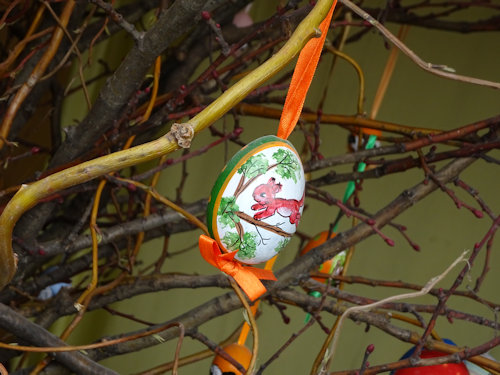
(Painted egg hanging from branches: a local tradition)
The first question many people ask about Vienna’s Easter markets is “are they like the Christmas markets?”.
How could they be?
The Christmas markets take place in a city bursting with a wide mix of seasonal scents, sounds, lights and colours.
Easter means more eggs and chocolate rabbits in the shops. No competition. (Though, to be fair, the chocolate Lindt rabbits deserve a place in the dining halls of the Greek Gods.)
Ask, though, whether it’s worth visiting an Easter market and the answer is a definite yes. Just don’t compare them to the Christmas experience.

(Enjoy plenty of food and drink)
In terms of what to expect, well, eggs for starters. Lots of them.
Just joking.
No, seriously…eggs.
Not tacky plastic ones or large chocolate ones encased in coloured foil, but decorated and decorative eggs: mostly hand-painted eggshells designed to hang on an Osterbaum (an “Easter tree” made from small thin willow branches or similar).
Otherwise, consider the Easter markets good quality arts and crafts markets, with a tasty dose of regional cuisine thrown into the mix.
Even without any wintry ambience or Christmas punch, it’s nice to browse the stalls, sip a glass of Austrian wine, and sample a wild boar sausage or a bowl of vegetarian goulash.
Visitor info & tips
The Easter markets tend to start around 2½ weeks before Easter and usually run through to Easter Monday.
See here for specific dates and times as they become available: I expect the main markets to start up around April 4th/5th and continue until April 21st/22nd (but no dates are yet confirmed at the time of writing).
Market hours vary between markets, but they commonly open mid-morning and close sometime in the evening (6-9pm).
Saturdays, Sundays and the long Easter weekend, in particular, can get quite busy. Go earlier in the day to avoid the crowds.
I once visited the Schönbrunn market, for example, on a Good Friday, which was delightful. However, other folk had the same idea; viewing the craft stalls proved easy enough, but the food stalls had long queues.
The main markets
The three largest, most popular and most convenient markets for visitors to the city in 2025 are probably:
1. Schönbrunn
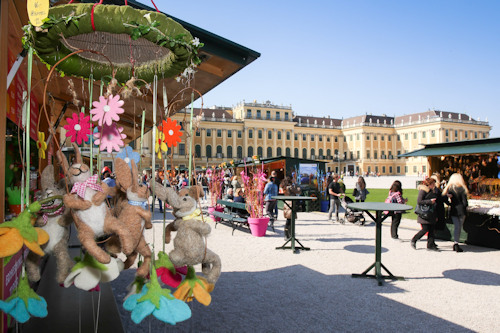
(Schönbrunn Easter Market; press photo © www.ostermarkt.co.at / FOTOFALLY)
The Ostermarkt Schloss Schönbrunn has the best setting of all.
The market sits in the huge courtyard in front of Schönbrunn Palace, where Imperial children hunted for eggs in Easters gone by. Or probably not. Or, if they did, they presumably got their servants to do the hunting for them.
Anyway, this wonderful market has always been full of high-quality wares as well as regional specialties to keep your hunger at bay. A new organiser and concept is expected in 2025, though, so I await news of any changes.
2. Am Hof
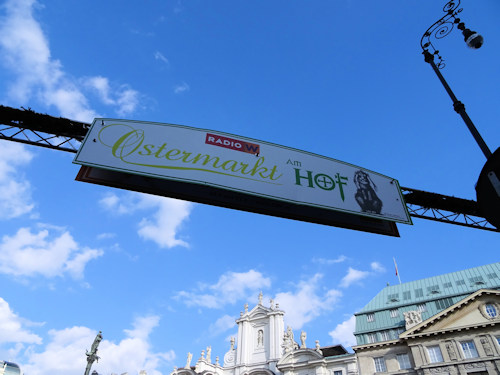
(Welcome sign at the Ostermarkt am Hof)
The Ostermarkt am Hof scores points for artistic merit and culinary offerings.
A whole section devotes itself to artists and artisans, ensuring unique and original products for sale, while the food and drink stalls cater to a wide variety of tastes (but especially to those of us with a sweet tooth).
The location is more central than Schönbrunn and rather historical: a large square where Mozart gave his first public performance in Vienna and Roman children once unwrapped their chocolate Easter rabbits (only one of those facts is true).
3. Freyung
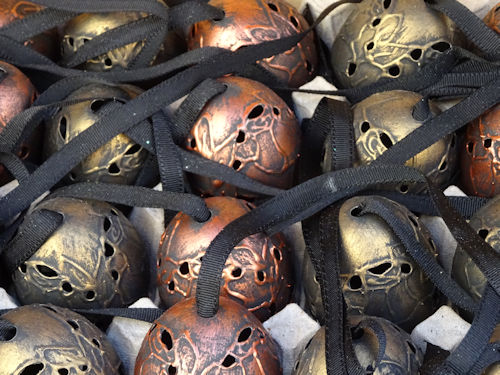
(A sample of decorative eggs)
The Altwiener Ostermarkt also opens near the city centre, outside the Schottenstift monastery that dates back to the 12th century.
Call in here for your decorative eggs. Hundreds (possibly thousands) dominate the market’s centre at a huge open stall.
The Freyung market is another place to sample regional food and drink, thanks to the organic farmers’ market typically held on the other side of the narrow road.
Short-term & smaller markets
Vienna has several other “Ostermärkte” that may make an appearance, depending on the year. Here a selection of those likely of most interest to visitors to the city. Check locally to see if they take place…
Hirschstetten
The municipal botanic gardens are a little out the way, but hosts a market and spring activities around the Easter weekend. I love the Advent market there, as well.
(This one definitely takes place in 2025: details here once available.)
Kalvarienbergfest
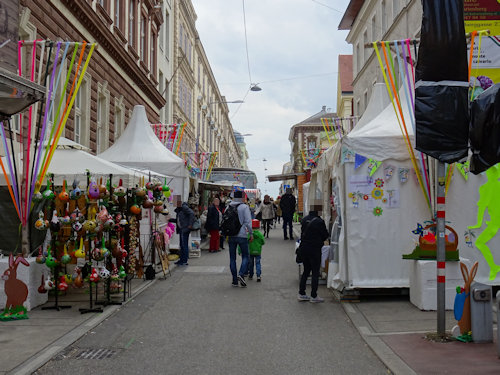
(Street market flair on the Kalvarienberg)
A local event in Vienna’s outlying 17th district with a long tradition; the Kalvarienbergfest is a rejuvenated version of a historical Lent market.
This street festival is not really intended to compete with the others, but instead offers locals a bit of entertainment, culture, art, kids activities, and (most importantly) fried snacks.
Michaelerplatz
A small market on Michaelerplatz, right in the very centre of town, popped up back in 2023. The main advantage was you could sample a few Easter treats while also appreciating the quite remarkable historical ambience of the surrounding square, which dates back to Roman times.
Palais Niederösterreich
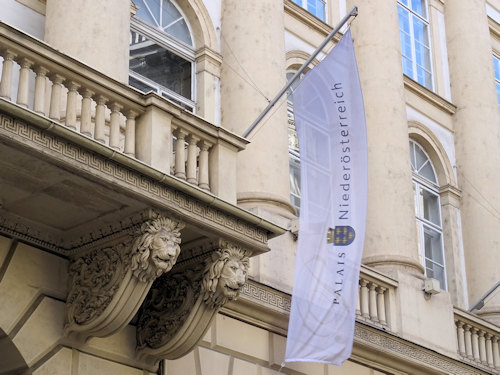
(The palais still has some Renaissance interiors)
This Easter market offers something a little different, being largely inside and usually only lasting two days.
The Oster-Erlebnismarkt gives you a taste (literally) of the province of Lower Austria, with food, drink, arts, crafts, and music from the rural province.
The market also provides a rare opportunity to go inside Palais Niederösterreich, a central palais with beautiful renaissance and baroque rooms.
After the markets?
Vienna has other delights to offer at Easter, of course, once you’ve had your fill of crafts and chocolate-coated fruit.
In particular, the concert season is in full swing, and the art exhibitions tend to reach one of their annual high points in spring.
By the time Easter 2025 comes around, for example, we should have some of the year’s highlight exhibitions up and running.
Lower Belvedere has already announced a special Klimt exhibition. And the Kunsthistorisches Museum one around the likes of Arcimboldo, Bassano and Bruegel.